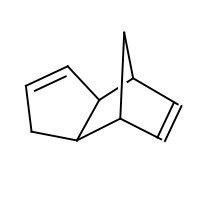Dicyclopentadiene
Agent Name
Dicyclopentadiene
CAS Number
77-73-6
Formula
C10-H12
Major Category
Other Classes

Synonyms
1,3-CPD; 1,3-Cyclopentadiene, dimer; 3a,4,7,7a-Tetrahydro-4,7-methanoindene; 4,7-Methano-1H-indene, 3a,4,7,7a-tetrahydro-; 4,7-Methanoindene, 3a,4,7,7a-tetrahydro-; Bicyclopentadiene; Biscyclopentadiene; Cyclopentadiene dimer; Dicyclopentadiene; Dicyklopentadien [Czech]; Dimer cyklopentadienu [Czech]; Tricyclo(5.2.1.0)-3,8-decadiene; alpha-Dicyclopentadiene (endo form); [ChemIDplus] UN2048; UN1993; UN2929
Category
Aliphatics, Unsaturated
Description
Colorless, crystalline solid with a disagreeable, camphor-like odor; Note: A liquid above 90 degrees F; [NIOSH]
Sources/Uses
Used as a chemical intermediate for insecticides and other products; [ACGIH] Used as a monomer and curing agent in polymer production; [HSDB]
Comments
Exposed workers experienced headaches. "The proposed TLVs arre expected to protect against CNS effects (tremors, loss of coordination, and unsteady gait) seen at 33 ppm in mice exposed for 9 days in one unpublished study." [ACGIH] A skin, eye, and respiratory tract irritant; [ICSC] In animal experiments, calves are intoxicated at a dose of 250 mg/kg. [HSDB] See "Cyclopentadiene."
Biomedical References
Exposure Assessment
Skin Designation (ACGIH)
Insufficient data
TLV (ACGIH)
0.5 ppm
STEL (ACGIH)
1 ppm
MAK
0.5 ppm
Vapor Pressure
2.3 mm Hg
Odor Threshold Low
0.003 ppm
Odor Threshold High
0.01 ppm
Lethal Concentration
LC50 (rat) = 660 ppm/4h
Explanatory Notes
Detection odor threshold from AIHA (mean = 0.011 ppm); Flash point = 32 deg C; VP from HSDB;
NFPA
may ignite at ambient temp
ERPG-1
0.01 ppm
ERPG-2
5 ppm
ERPG-3
75 ppm
Adverse Effects
Neurotoxin
Acute solvent syndrome
Hepatotoxin
Hepatoxic (a) from occupational exposure (secondary effect) or (b) in animal studies or in humans after ingestion
Diseases, Processes, and Activities Linked to This Agent
Diseases
Occupational diseases associated with exposure to this agent: